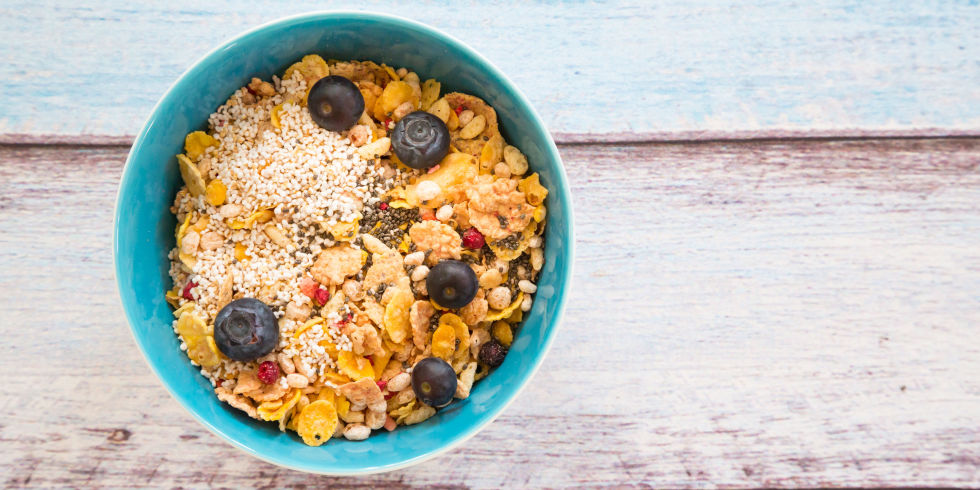
Just because something sounds healthy, or is marketed as being so, doesn’t mean that it necessarily is. We asked the industry experts to tell us about some of the foods that are being wrongly perceived as a ‘healthy’ choice, both in the media and by their clients…
1. Granola bars
“These are probably the most common mistake I see with so many new clients I meet and are the first thing I cross off their list,” says Michelle Braude, Doctor & Nutritionist. “They all tell me how healthy they are, as they only snack on granola bars during the day, rather than buying a chocolate bar at work. The problem is that most granola bars are highly processed, and laden with refined sugar, unhealthy oils, calories and fat. Not to mention the addition of chocolate chips or a drizzle of white chocolate! Even without those things, many of those bars are higher in calories, and have more grams of fat and sugar than many chocolate bars. However, because they contain oats, nuts and perhaps dried fruit, my clients and many others, are tricked into believing they’re healthy.
Swap it for: “A far better alternative is a handful of plain almonds or cashew nutsand a small serving of dried fruit such as raisins, or half a cup of berries, such as blueberries or raspberries. This provides the perfect combination of protein, fibre, natural fruit sugars and heart-healthy unsaturated fats, keeping blood-sugar levels stable, and cravings at bay!”
2. Breakfast biscuits
These products claim to provide you with hours of nutritious steady energy on-the-go, but the reality is quite different explains Rhiannon Lambert, Registered Nutritionist. These biscuits are in fact low in protein and high in sugar, and she explains that: “the need for protein is essential when it comes to keeping blood sugar levels balanced.”
“These breakfast biscuits contain around 13g of sugar per serving, that is equivalent to 3 teaspoons of sugar – the same as a small chocolate bar. We all need to watch our sugar intake and eating biscuits for breakfast is never going to be a nutritious or healthy option on-the-go”.
Swap it for: “I always advise clients to boil some eggs and keep them in the fridge for a perfect nutrient and protein rich breakfast. Alternatively, make a lunch box of overnight oats. These can then be eaten as a ‘bircher-style’ porridge on-the-go, without any added sugar. You can even add some healthy protein powder to boost the protein content and slow the release of sugars.”
3. Shop-bought green juices
The process of juicing involves removing the fibre from the fruit and vegetables. “Without the fibre, the nutrients in a juice get absorbed speedily into the bloodstream, which gives us that initial burst in energy,” explains Rhiannon. “However, a problem arises when that same lack of fibre results in such a fast release of sugars that it can cause a spike in your blood sugar. This often leads to a massive dip in energy, and cravings for sugary items throughout the day.”
But what about all the green vegetables these juices contain, surely they’re good for us? “It only takes a small amount of spinach to turn a pineapple or apple juice green, and many of the bottled juices out there use a lot of fruit to make the juice go further and of course taste more palatable,” says Rhiannon. Also, most bottles of juice contain two servings, although you’d never know this unless you examined the small print. “A Nakd Green Machine juice (415ml) contains 52g of sugar, that’s the equivalent to a 90g bar of milk chocolate! A Pret Green Goodness (400ml) has 42.8g of sugar, equivalent to 330ml can of Cherry Coke.”
Swap it for: A piece of fruit or some raw vegetables such as carrots, cucumber or celery. The fibre they contain will both slow sugar release and help to sustain energy levels. Team fruit with yoghurt or nuts and veggies with a dip such as hummus or tzatziki for some satiating protein. Keep juices as a treat food!
4. ‘Low-calorie’ frozen ready meals
“Low-calorie frozen meals are very often high in sodium (salt) and added sugars,” explains Registered Dietitian Amanda Kruse. “More importantly though, the portions are generally quite small and may lead to individuals over-eating later – especially if they’re not pairing it with other foods (such as salad, fruits or dairy). Additionally, you may feel like you’re getting multiple vegetable servings when, in reality, there may only be a 1/4 cup of vegetables in a frozen meal.”
Swap it for: Amanda suggests instead to opt for one of her favourite go-to ready meals…
Garlic-herb chicken breast w/peppers and onions: brown rice or quinoa, and a side of seasoned edamame. Prep the following in bulk (three days worth) so all you have to do is grab a container.
- Bake 3 chicken breasts with 250g frozen sliced peppers and onions, 3 tbsp chopped garlic, 2 tbsp Italian seasoning, and 1 drizzle olive oil
- Follow directions on packaging to yield 3 cups of brown rice or quinoa
- Portion each chicken breast with a cup of rice in a heat-safe container
- Heat in microwave before serving
- Mix 1/2 bag frozen un-shelled edamame with 1 tbsp. olive oil, 1 tsp chilli sauce, 1 tsp garlic powder, and sprinkle of sea salt
- Prepare frozen, then refrigerate
- Eat chilled or at room temperature
5. Gluten-free foods
Gluten-free foods are often perceived as being ‘natural’ or ‘healthier’ foods, and food manufacturers are creating products that pander to this perception, advise Accredited Practising Dietitians Alex Parker and Anna Debenham.
“Despite the media hype, there is no evidence that adopting a gluten-free diet has any additional health benefits for those of us without coeliac disease or a gluten intolerance. A gluten-free diet is restrictive, complex, expensive and time-consuming,” they explain. “When gluten is removed from foods such as flours and bread, they lose their soft, elastic texture. In order to achieve a palatable product, other refined properties are often added, such as processed fibres and stabilising gums.”
“Gluten-free foods have not been linked with weight loss, they usually contain around the same (if not more) calories, fat and carbohydrates as regular products. Additionally, they often contain less fibre- a nutrient essential for optimal bowel health.”
Swap it for: “Choose foods rich in wholegrains to maximise fibre, vitamins and minerals, phytonutrients and protein. Include a variety of wholegrains to maximise enjoyment and nutrition, and experiment with ancient grains (such as spelt, quinoa, millet and amaranth) as a way to boost your overall wholegrain intake”.
6. Vitamin water
The deceit is in the name of these drinks, explains Accredited Practising Dietitian Neelam Pun, which gives the impression that it they are simply water that has been fortified with vitamins. “These products are also labelled with buzz words like “essential” and “revive”, which further suggest that they will provide a nutritious boost. They come in bright colours with fruity names, reiterating the illusion that they contain fruit.”
The truth? “Unfortunately these products are nothing more than glorified sugar water,” says Neelam. “Despite the fruity names, they contain little in the way of real fruit, but contain approximately six teaspoons of added sugar per bottle. They also come in large 500ml sizes which encourages drinking more than we need, even when we are full.”
Swap it for: “There is no substitute for plain water as it is will hydrate the body and satisfy thirst without any calories. If craving a bit more flavour, try adding things like fresh lemon slices, mint leaves, ginger and/or berries to still or sparkling water for a healthy infusion of sweetness.”
7. Coconut Oil
Coconut oil has been heavily marketed in recent years as a ‘cure-all’ elixir says Dietitian and Exercise Physiologist Michael Lawler, but unfortunately this is based purely on speculation, and not on any evidence. “I have read misinformed articles about coconut oil’s ability to do just about everything from curing cancer to beating diabetes, leading to amazing weight loss, regrowing lost hair and detoxifying your body!” he says. “The majority of the media misinformation and healthy hype on these products are driven by marketing companies on behalf of coconut product manufacturers, and not from university studies, double blind trials or population studies,” Michael goes on to explain.
“The reality is that coconut oil and most coconut related health food products are high in (cholesterol-raising) saturated fat. Coconut oil is also very high in calories which makes it easy to overeat, and therefore has a strong potential to make weight management quite difficult in well-meaning health converts. I have seen a new wave of heart disease clients coming in to see me with very, very high total and LDL cholesterol levels after switching over to coconut everything in their diet”.
Swap it for: “If you are looking for a healthy cooking oil, stick to olive oil (ideally extra virgin olive oil). Use coconut oil sparingly, and treat it like butter or other animal fats.”









